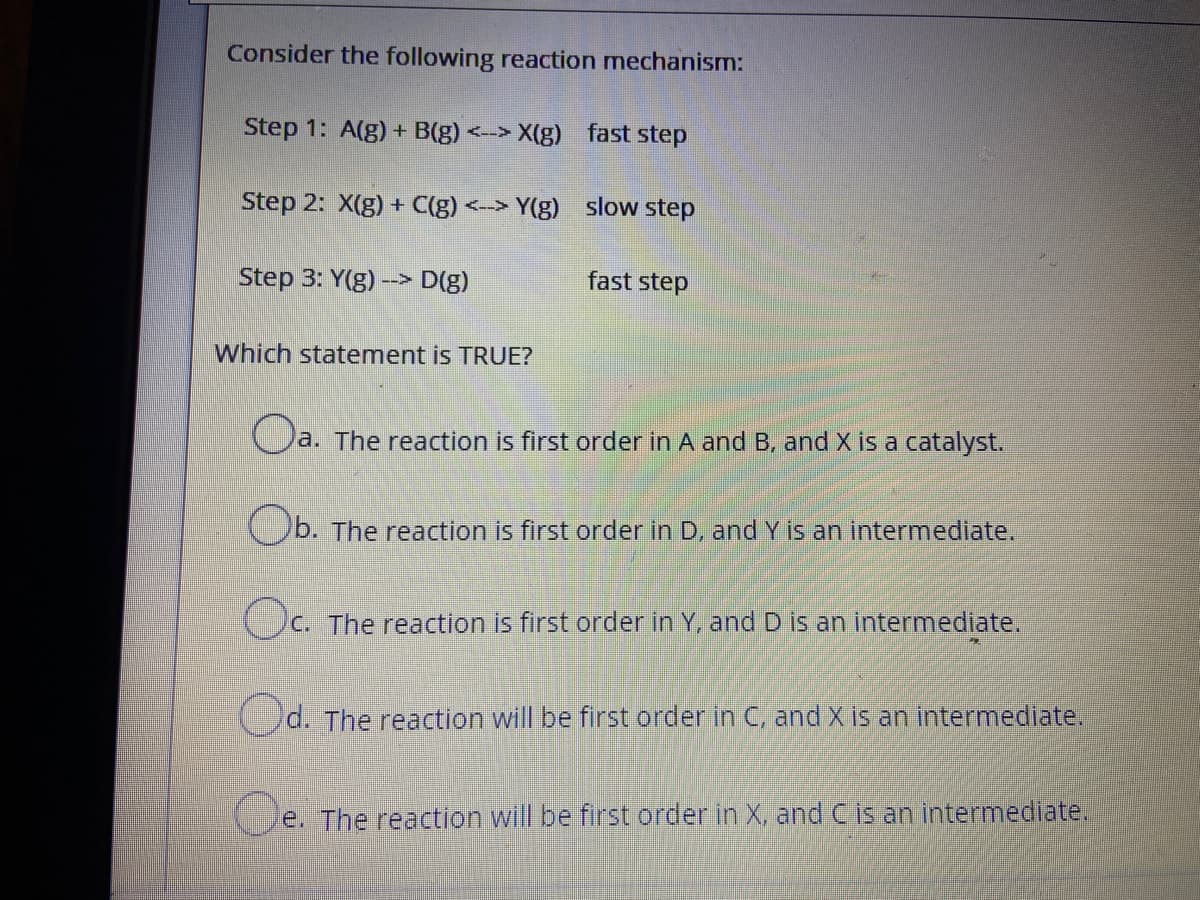Consider the following reaction mechanism: Step 1: A(g) + B(g) <-> X(g) fast step Step 2: X(g) + C(g) <--> Y(g) slow step Step 3: Y(g) --> D(g) fast step Which statement is TRUE? a. The reaction is first order in A and B, and X is a catalyst. Ob. The reaction is first order in D, and Y is an intermediate. Oc. c. The reaction is first order in Y, and D is an intermediate. d. The reaction will be first order in C, and X is an intermediate. e. The reaction will be first order in X, and C is an intermediate.
Consider the following reaction mechanism: Step 1: A(g) + B(g) <-> X(g) fast step Step 2: X(g) + C(g) <--> Y(g) slow step Step 3: Y(g) --> D(g) fast step Which statement is TRUE? a. The reaction is first order in A and B, and X is a catalyst. Ob. The reaction is first order in D, and Y is an intermediate. Oc. c. The reaction is first order in Y, and D is an intermediate. d. The reaction will be first order in C, and X is an intermediate. e. The reaction will be first order in X, and C is an intermediate.
Chemistry for Engineering Students
4th Edition
ISBN:9781337398909
Author:Lawrence S. Brown, Tom Holme
Publisher:Lawrence S. Brown, Tom Holme
Chapter11: Chemical Kinetics
Section: Chapter Questions
Problem 11.65PAE
Related questions
Question

Transcribed Image Text:Consider the following reaction mechanism:
Step 1: A(g)+ B(g) <-> X(g) fast step
Step 2: X(g) + C(g) <-> Y(g) slow step
Step 3: Y(g) --> D(g)
fast step
Which statement is TRUE?
O
a. The reaction is first order in A and B, and X is a catalyst.
Ob. The reaction is first order in D, and Y is an intermediate.
C. The reaction is first order in Y, and D is an intermediate.
Od. The reaction will be first order in C, and X is an intermediate.
e. The reaction will be first order in X, and C is an intermediate.
Expert Solution
This question has been solved!
Explore an expertly crafted, step-by-step solution for a thorough understanding of key concepts.
This is a popular solution!
Trending now
This is a popular solution!
Step by step
Solved in 2 steps

Knowledge Booster
Learn more about
Need a deep-dive on the concept behind this application? Look no further. Learn more about this topic, chemistry and related others by exploring similar questions and additional content below.Recommended textbooks for you

Chemistry for Engineering Students
Chemistry
ISBN:
9781337398909
Author:
Lawrence S. Brown, Tom Holme
Publisher:
Cengage Learning

Principles of Modern Chemistry
Chemistry
ISBN:
9781305079113
Author:
David W. Oxtoby, H. Pat Gillis, Laurie J. Butler
Publisher:
Cengage Learning


Chemistry for Engineering Students
Chemistry
ISBN:
9781337398909
Author:
Lawrence S. Brown, Tom Holme
Publisher:
Cengage Learning

Principles of Modern Chemistry
Chemistry
ISBN:
9781305079113
Author:
David W. Oxtoby, H. Pat Gillis, Laurie J. Butler
Publisher:
Cengage Learning


Chemistry
Chemistry
ISBN:
9781305957404
Author:
Steven S. Zumdahl, Susan A. Zumdahl, Donald J. DeCoste
Publisher:
Cengage Learning

Chemistry: An Atoms First Approach
Chemistry
ISBN:
9781305079243
Author:
Steven S. Zumdahl, Susan A. Zumdahl
Publisher:
Cengage Learning

Physical Chemistry
Chemistry
ISBN:
9781133958437
Author:
Ball, David W. (david Warren), BAER, Tomas
Publisher:
Wadsworth Cengage Learning,